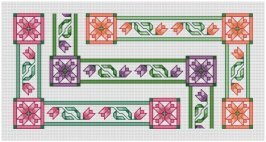How to Pick Cross Stitch Needles
You might reasonably think that you could skip this section on cross stitch needles. After all, if you have needles around the house, you don't need any more of them. But success means having the right tools for the job. Don't skip this very important information!
While it's easy to get lost in the haystack of needles at your local craft or sewing store, we'll be using needles with specific traits. Understanding them will make picking the correct ones quick and easy.
How to buy cross stitch needles
Typical sewing needles vary in length, thickness, sharpness and eye size. Walk right past these. Any sewing store that sells embroidery supplies will display the needles you want with the floss, instead of with standard sewing needles.
There, you will find the three types used for embroidery: crewel (or embroidery), chenille and tapestry. Curiously, even with the tremendous popularity of counted cross stitch, you may find it difficult to find something labeled as a "cross stitch needle." And some of the ones I have found, do not work well for cross stitch.
Choosing the right needle is easier than you think
As with any type of needlework, the specific needle to pick depends on
- the embroidery technique
- the floss or yarn used
- the fabric being stitched
As you examine these needles closely, notice that
- the number represents the size of the needle
- the higher the number, the smaller the needle
- the needles have larger eyes than regular sewing needles--a must for using with floss
The purpose of your needle is to open the weave of the fabric so the floss can easily pass through.If the needle is too small, the floss will fray a little more each time it is pulled through the cloth. On the other hand, too large a needle can can distort the small holes in any even weave material (such as Aida cloth) with a thread count higher than 18.
With this in mind, look at the characteristics of the three main types of needles you'll encounter.
- are sharp pointed
- range in size from 1 to 10
- used for standard embroidery stitched on common fabric such as stamped designs on pillow cases, towels, etc.
- are sharp pointed
- range in size from 13 to 26
- longer, thicker and with larger eyes
- a good choice for embroidery with heavier yarn
- range in size from 13 to 28
- blunt rather than sharp
- the ideal choice for counted cross stitch
- receive my nomination for the title, "cross stitch needles"
I use Tapestry needles, size #26, almost exclusively. The blunt tip works perfectly for "finding" the hole by feel. Sharp needles so easily pierce the fabric that I typically keep stitching; I don't realize the mistake until I come back and stitch adjacent to it. The blunt tip of the tapestry needle helps avoid this problem.
It's frustrating to sort through multiple needle sizes. Since I most often use 11- to 18-count fabric, I find that #26 tapestry needles are the most versatile. I also keep a few of the next larger size, #24, on hand; I use them when I have too many strands of floss to easily thread through the eye of a #26, or when using metallics or blending filament (click here for more tips on using specialty floss).
You may be able to find counted cross stitch needles in a combo package containing both #24 and #26 needles. Buy one package to start. (Ignore the notation on the package that says, "For 18 and 22 Count Fabric.") Since your hand size and dexterity may also affect which feels most comfortable, work with them and settle on the size you like best.
I've noticed that children like the larger needles. They start with the smaller fabric counts (hence larger holes in the fabric), so larger needles work fine for them.
Found your favorite needle?
Buy lots of them!
If you're like me and stitch in almost any room (not to mention taking small projects along with you outside the house), you'll never believe how many cross stitch needles you can lose. You'll be even more amazed at the places you'll find them!
It's also a good idea to keep a couple of #24 and #26 Chenille needles on hand. (Remember, these come in the same sizes but have a sharp point.) Sometimes a design will call for stitching on top of stitching (backstitching for an outline, a french knot for an eye, etc.). A blunt-tipped needle can make it difficult to pierce an area of dense stitching, especially if it lands in the middle of a stitch instead of in the holes. When this happens, just switch to a sharp needle.
Now that you've put cross stitch needles on your list, it's time to add a needle threader, too. Yes, you do need one.
Home › Counted Cross Stitch Supplies › Needles
